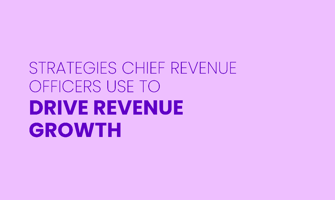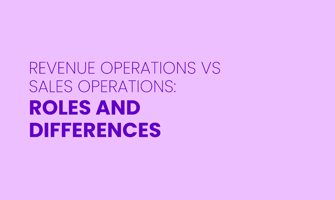The quest for efficiency, increased productivity, growth, and cohesion within organizations has led...
Key Responsibilities of a Chief Revenue Officer
Chief Revenue Officers (CROs) integrate sales, marketing, and customer engagement to optimize a company's revenue generation. They align various functions to ensure consistent and measurable revenue outcomes.
This article explores the core responsibilities of CROs, highlighting how their strategic initiatives impact financial performance and contribute to overall business success. Understanding these roles can help you leverage the full potential of your revenue operations.
Why the Responsibilities of a Chief Revenue Officer Matter
Chief Revenue Officers (CROs) influence all revenue-related activities, shaping the company's growth trajectory. By staying attuned to market trends and customer preferences, they ensure strategies are both reactive and proactive.
A dedicated CRO integrates efforts from various departments:
-
Marketing and Sales: Coordinating campaigns and sales initiatives to maximize lead conversion.
-
Customer Success: Ensuring ongoing customer satisfaction and retention.
-
Product Innovation: Aligning new product features with market demand.
This integration is essential for capturing market share and achieving financial targets, especially for start-ups and growth companies.
CROs excel at using data analytics to distill insights and drive growth. For example, they might identify customer behavior trends that lead to new sales strategies. Their ability to convert leads into sales opportunities can significantly impact growth.
Strategic partnerships are also part of the CRO's responsibilities. These partnerships can open new distribution channels and provide growth opportunities. By forging these alliances, CROs help the business scale and reach new markets.
The CRO's role encompasses visionary strategic planning. They align all revenue-related activities with the company's mission and objectives, ensuring sustained growth and success.
Key Responsibilities of a Chief Revenue Officer
1. Revenue Growth and Strategy Development
A Chief Revenue Officer (CRO) must create a revenue strategy that adapts to market conditions. Tools like data analytics help track market trends, competitor activities, and customer behavior, providing a factual basis for decisions.
Setting specific, measurable goals is key, as clear targets enable the CRO to map out precise steps to achieve them. For instance, if the goal is to increase revenue by 10% in one year, the strategy might include initiatives like expanding the sales team, increasing digital marketing efforts, and entering new markets.
Techniques like SWOT analysis help in identifying internal strengths and weaknesses, as well as external opportunities and threats. By using these techniques, the CRO can better prepare the company to face challenges and seize opportunities. Revisiting the SWOT analysis periodically ensures that the strategy remains relevant and effective as market conditions evolve.
![]()
2. Sales Leadership and Management
Effective sales leadership involves guiding the sales team to exceed targets while fostering motivation and skill development. Chief Revenue Officers (CROs) provide ongoing training to improve team performance. Regular training sessions and workshops can help the sales team stay updated with the latest techniques and trends.
Defining a clear sales process and enhancing efficiency are key responsibilities. Implementing Customer Relationship Management (CRM) systems streamlines operations and boosts team collaboration by managing customer interactions and data. This ensures that sales efforts are organized and aligned with the company's revenue goals. By fostering a collaborative environment, CROs ensure that the sales team works efficiently towards achieving set targets.
Effective sales leadership involves curating a culture of success and ambition, setting the tone, motivating the team, and providing the necessary resources for success."
3. Marketing Alignment and Strategy
Chief Revenue Officers ensure that marketing and sales efforts are coordinated. Collaborating with the marketing team allows the CRO to make sure that campaigns align with sales goals. This cooperation includes coordinating content creation, demand generation, and the use of marketing automation tools like software that automates repetitive marketing tasks.
Matching marketing strategies with the customer journey is necessary. For instance, understanding the stages a customer goes through, from initial awareness to final purchase, enables the CRO to optimize touchpoints like website visits, email interactions, and social media engagements.
This alignment helps convert marketing-qualified leads, potential customers identified by the marketing team, into sales-qualified leads who are ready for direct sales efforts.
Using data analytics, CROs tailor marketing messages to customer preferences, increasing the likelihood of conversions and driving revenue growth.
4. Customer Acquisition and Retention
Chief Revenue Officers focus on acquiring new customers while retaining existing ones. This dual responsibility requires understanding the entire customer journey in both B2B and B2C contexts, so strategies are tailored to specific needs and pain points.
For customer acquisition, CROs use data-driven insights to target efforts where they are most likely to convert leads. Personalizing engagement tactics ensures that potential customers feel valued and understood, increasing the likelihood of turning them into actual clients.
Retention strategies focus on meeting customers' evolving needs. Chief Revenue Officers ensure satisfaction through customer service, feedback, and communication. By continuously engaging and exceeding expectations, CROs increase customer lifetime value, supporting long-term revenue stability and growth.
5. Data Analytics and Performance Measurement
CRO oversees data analytics to inform strategic decisions. Using insights from revenue management systems, they identify trends, adapt strategies, and measure performance. These systems collect and analyze data related to sales, customer behavior, and market conditions.
Generative AI, a technology that can create new content and insights from existing data, helps in identifying hidden opportunities. For example, AI algorithms might reveal patterns in customer purchasing behavior that are not immediately obvious, allowing more precise targeting of marketing efforts.
You can use advanced solutions like those provided by 180ops to enhance your revenue operations using AI-driven tools.
CROs establish clear metrics and Key Performance Indicators (KPIs) to measure success, such as sales growth percentage or customer acquisition cost. By setting these benchmarks, CROs create a culture of accountability and continuous improvement. Understanding why certain metrics are met or missed helps in making necessary adjustments, and ensuring effective revenue generation efforts.
6. Cross-Departmental Collaboration
Effective revenue operations rely on strong cross-departmental collaboration, especially in B2B companies. CROs lead efforts to integrate strategies across various teams, like sales, marketing, product development, and customer success. By coordinating these departments, CROs ensure that resources and insights are shared, creating a unified approach to revenue generation.
For example, collaborating with product development can help tailor offerings to better meet customer needs, identified through sales and customer success teams' feedback.
CROs also play a key role in establishing and maintaining strategic partnerships and alliances. These relationships can open new revenue channels and provide additional resources and insights.
By fostering a collaborative environment, CROs build a sustainable ecosystem that supports continuous revenue growth. This seamless integration across departments ensures that the company can quickly adapt to market changes and maintain its competitive edge.
![]()
7. Product Strategy and Pricing
CROs are crucial in developing product strategies and pricing models that meet market demand. They need a deep understanding of the product's value proposition—how the product benefits the customer and stands out from competitors.
Dynamic pricing strategies are often employed. These strategies adjust prices based on market segments, demand, and distribution channels. For instance, a product might be priced higher in regions where demand is strong and lower in more price-sensitive markets.
CROs oversee the product portfolio to ensure offerings are innovative and financially viable. Their oversight involves continuous market research to keep the product strategy customer-focused, addressing actual needs. This focus drives sales and distinguishes the product in the market, significantly contributing to the company's profitability.
Chief Revenue Officers ensure that product strategy and pricing models align with market demand, customer value, and business goals.
8. Market Expansion and Business Development
CROs identify and capitalize on new market opportunities for business expansion. They evaluate new territories and demographics, understanding regulatory requirements, cultural nuances, and competitive dynamics in these regions.
Business development under a CRO's leadership uses both analytics and market intelligence. Data-driven insights guide decisions on where and how to expand. For example, if analytics show a high demand for a particular product feature in a specific region, the CRO might prioritize that area for market penetration.
The CRO leads initiatives targeting growth and scalability, which can involve launching new product lines, offering additional services, or creating innovative go-to-market strategies. By carefully planning and executing these expansions, CROs help the business grow sustainably and competitively.
9. Financial Revenue Planning and Forecasting
CROs must excel in financial planning and forecasting. This involves working closely with the finance team to develop models that predict future revenue streams. These models are crucial for securing investments and guiding how resources are allocated within the company.
For accurate forecasting, CROs analyze various elements such as sales pipelines, subscription renewals, and potential churn rates (the rate at which customers stop using a product). By examining this data, they can predict future revenue more precisely. This blend of detailed data analysis and big-picture financial planning ensures the business remains financially stable and can grow sustainably.
![]()
10. Stakeholder Communication and Reporting
CROs are important in communicating with various stakeholders, including internal teams, executive boards, external partners, and investors. Clear and transparent communication is key to keeping everyone informed and aligned with the business's objectives.
CROs must present progress, set realistic expectations, and share critical insights to guide decision-making. This includes translating complex data and analytics into understandable insights. For example, a detailed sales report might highlight key trends, successes, and areas for improvement, helping stakeholders make informed decisions.
By effectively communicating complex revenue-related concepts, CROs ensure that all stakeholders understand the strategic roadmap and are aligned with the business goals. This alignment helps the revenue generation efforts to operate efficiently and supports the overall growth strategy.
Conclusion
Chief Revenue Officers (CROs) are essential for driving a company's financial performance and growth. Through strategic initiatives and practical execution, they ensure that all revenue-related functions are aligned and optimized.
By harnessing data analytics, fostering cross-departmental collaboration, and leading market expansion efforts, CROs help businesses overcome challenges and seize opportunities. Their impact extends to the long-term success and sustainability of the company.
In essence, the CRO guides the revenue generation engine, ensuring the company remains competitive and thrives in a dynamic market. Understanding and leveraging the role of a CRO can significantly enhance your overall business performance.
FAQs
What is the typical job description for a Chief Revenue Officer (CRO) role?
Chief Revenue Officers (CROs) are part of the executive team and focus on accelerating revenue growth. Their job description includes overseeing sales and marketing efforts, aligning various functions to optimize the revenue generation engine, and ensuring that company objectives are met. CROs collaborate with other corporate officers to create strategies that drive financial performance.
How do CRO roles differ from other related job titles like VP of Sales?
While both CROs and VPs of Sales are crucial for a company's revenue strategy, their roles and functions differ. A VP of Sales primarily focuses on sales team management and hitting sales targets. In contrast, the CRO role encompasses a broader scope, including marketing, product strategy, and overall revenue growth, making it essential for aligning all revenue-related activities within the executive team.
What qualifications and skills are necessary for someone looking to write a profile for a CRO role?
To profile a Chief Revenue Officer, one should mention essential qualifications such as extensive experience in sales and marketing, strong leadership roles in B2B or B2C companies, and the ability to develop and execute strategic initiatives. Key skills include analytical thinking, excellent communication, and the capability to collaborate with various departments to drive the revenue engine.
How do Chief Revenue Officers help companies excel in their revenue generation efforts?
CROs use a mix of marketing and sales strategies to optimize revenue generation. They focus on understanding market trends, and customer needs, and integrating these insights into a cohesive plan. By doing so, they help companies excel in capturing market share, meeting financial targets, and ensuring long-term business sustainability.
What bold moves can CROs make to strengthen the revenue generation engine in a company?
Chief Revenue Officers (CROs) can make bold moves such as entering new markets, forming strategic partnerships, and employing data analytics to drive decision-making. These actions not only accelerate revenue growth but also position the company as a leader in its industry. By putting these strategies into action, CROs can significantly impact the overall success of the organization.




